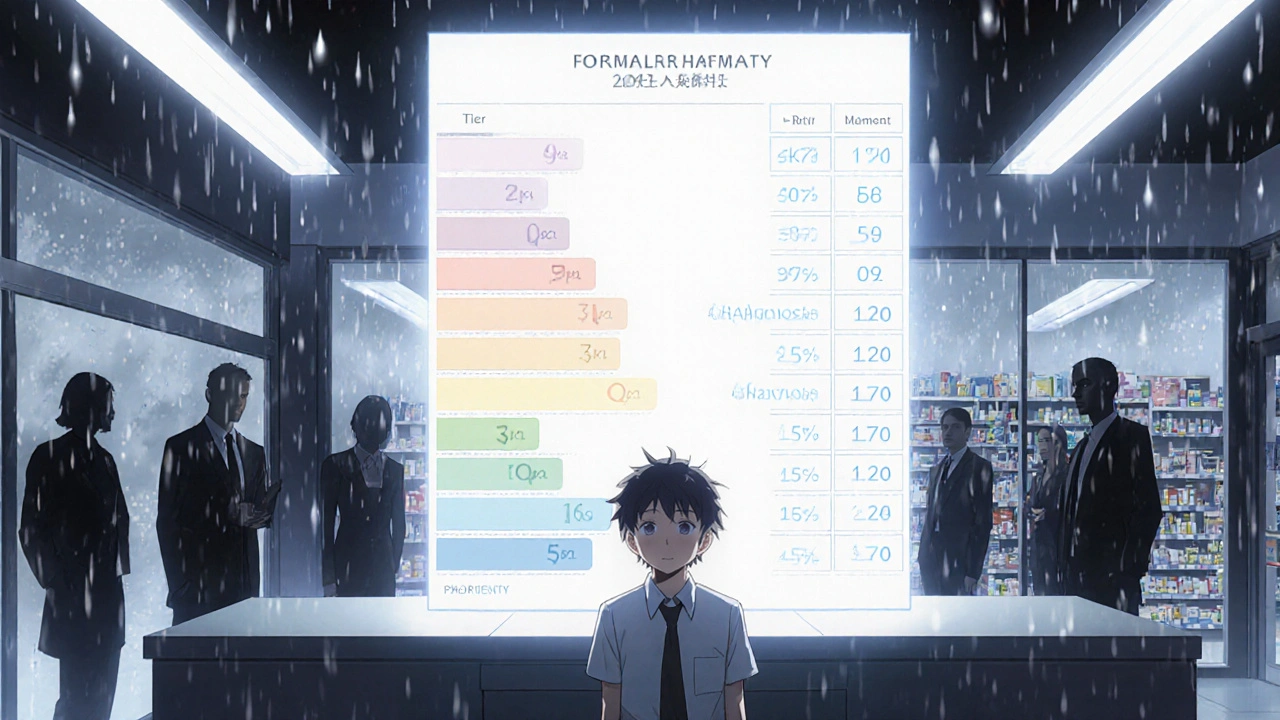How to Safely Navigate Prescription Drug Formularies When Insurance Changes Meds
 Oct, 25 2025
Oct, 25 2025
Formulary Cost Calculator
Formulary Tier Guide
Tier 1 (Generic)
$0 - $10
Tier 2 (Preferred Brand)
$25 - $50
Tier 3 (Non-Preferred Brand)
$50 - $100
Tier 4/5 (Specialty)
$100+ or % of drug cost
Current Medication Details
Cost Impact Calculator
Cost Impact Analysis
Medication Management Options
- Ask about generic alternatives
- Request a 90-day supply for lower copay
- Check for medical necessity exceptions
When your health insurance flips a switch and a medication jumps tiers or disappears altogether, the panic can feel instant. The good news? Most of the chaos can be tamed if you know how prescription drug formulary systems work and what steps to take the moment a change hits your pharmacy window.
What a Prescription Drug Formulary Actually Is
Prescription Drug Formulary is an official list of prescription medicines that a health‑insurance plan agrees to cover, along with the cost‑sharing rules for each drug. It’s built by a Pharmacy and Therapeutics (P&T) committee-typically a mix of pharmacists, physicians, and health‑economics experts-who weigh safety, clinical effectiveness, and price. The result is a tiered menu that tells you whether a drug is free, low‑cost, or requires a higher copay or prior‑authorization.
Why Formularies Matter to You
- They steer you toward clinically appropriate, lower‑cost alternatives, saving the average beneficiary about $1,845 a year.
- They protect you from surprise bills by setting clear copay amounts per tier.
- They can, however, create gaps if a drug you rely on moves to a higher tier or drops off entirely.
Understanding the structure helps you anticipate the impact before it hits your wallet.
Typical Tier Structures and What They Mean for Your Pocket
| Tier | Drug Type | Typical Copay |
|---|---|---|
| Tier 1 | Generic | $0 - $10 |
| Tier 2 | Preferred brand‑name | $25 - $50 |
| Tier 3 | Non‑preferred brand‑name | $50 - $100 |
| Tier 4/5 | Specialty (biologics, rare‑disease drugs) | $100+ or % of drug cost |
Commercial plans often use three tiers, while Medicare Part D usually spreads drugs across four or five. Knowing where your meds sit lets you gauge how a tier move will affect your out‑of‑pocket spend.
How to Spot a Formulary Change Before It Affects You
- Mark your enrollment window. For Medicare, the Open Enrollment Period runs Oct 15 - Dec 7. Commercial plans usually update in January.
- Locate the latest formulary. Log into your insurer’s portal, find the “Plan Materials” or “Drug List” section, and download the PDF or view the searchable web version.
- Search by drug name or therapeutic class. Use the built‑in search box; if the drug is missing, it may have been removed or moved to a higher tier.
- Check the “Effective Date” line. Changes can be scheduled for Jan 1, but mid‑year updates happen in ~23 % of plans.
- Set a reminder. If a change is slated for the upcoming month, call your pharmacy and prescriber early to discuss alternatives.
Doing this homework takes 2‑5 hours at most, according to a Kaiser Family Foundation study, but it saves you from painful surprises later.

When a Medication Moves or Vanishes: Immediate Action Plan
Step‑by‑step, here’s what to do the moment you discover a change:
- Confirm the change. Verify the tier shift or removal on the official formulary PDF, not just a screenshot.
- Ask your prescriber for alternatives. Physicians can suggest therapeutically equivalent drugs that stay on the lower tier.
- Submit an exception request. If no suitable alternative exists, the insurer must consider a “medical necessity” exception. Most plans approve 78 % of requests within 72 hours when the doctor supplies documented treatment failure or adverse reaction evidence.
- Document everything. Keep copies of the formulary excerpt, your doctor’s note, and the request confirmation number.
- Follow up. If the insurer stalls beyond the stated timeline (30 days for commercial, 60 days for Medicare), call the pharmacy benefit manager (PBM) and ask for escalation.
These actions drastically cut the risk of a treatment gap. A 2023 Consumer Reports survey found that beneficiaries who filed an exception within the first week experienced no interruption 92 % of the time.
Prior Authorization vs. Step Therapy: Knowing the Difference
Two common formulary hurdles often get mixed up:
- Prior Authorization (PA): The insurer asks the prescriber to justify why a specific drug is needed before covering it.
- Step Therapy (ST): You must try a cheaper alternative first; only if that fails can you “step up” to the pricier drug.
For specialty medications, 47 % of commercial plans require PA compared to 32 % of Medicare Part D plans. Knowing which applies to your drug helps you prep the right paperwork ahead of time.
Special Cases: Protected Drug Classes and Medicare Rules
Medicare Part D has six protected classes that must be covered without tier‑based restrictions: antidepressants, antipsychotics, immunosuppressants, HIV/AIDS meds, anticonvulsants, and antiretrovirals. Commercial insurers don’t have this mandate, so you might see more tier jumps in those areas.
Another Medicare quirk: if a drug is removed because the FDA withdraws it, the plan must give you at least 60 days notice-double the 30‑day rule for most commercial changes.
Tips for Reducing Costs While Staying Covered
- Ask if a generic version exists before accepting a brand‑name tier.
- Check if a 90‑day supply moves you into a lower per‑prescription copay.
- Explore “mail‑order” pharmacy options; many plans waive the tier fee for bulk shipments.
- Consider a “value‑based” formulary alternative-some large employers now tie drug placement to real‑world outcomes, which can mean better coverage for high‑impact meds.
- Stay aware of the Inflation Reduction Act cap (starting 2025) that limits out‑of‑pocket expenses for high‑cost drugs to $2,000 annually.

Common Pitfalls to Avoid
Even seasoned patients slip up. Here are the most frequent mistakes and how to dodge them:
- Relying on a single source. Insurers often host the formulary in a PDF while the customer portal shows a different list. Cross‑check both.
- Waiting until the last minute. Formulary updates can go live on Jan 1, but pharmacies need a few days to load the new tier info.
- Skipping the “medical necessity” paperwork. If you think the drug is essential, ask your doctor to explicitly mention prior treatment failures.
- Ignoring the specialty tier nuances. Specialty drugs may be covered under a separate “percentage of cost” model, not a flat copay. Clarify the exact dollar amount before you order.
Real‑World Stories: What Went Right and What Went Wrong
Success: A 78‑year‑old with dementia saw her medication removed Jan 2024. Her neurologist quickly filed an exception, the PBM approved within 48 hours, and there was no cost increase. The key was the doctor’s documented failure of alternative therapies.
Failure: A retiree in Florida discovered his heart drug jumped from Tier 2 to Tier 4 overnight. He spent three weeks on the phone with the insurer, finally getting a waiver after appealing to the state insurance commissioner. He ended up paying $405 extra in that month.
These anecdotes underline the power of early preparation and persistent follow‑up.
Quick Reference Checklist
- Locate your current formulary (PDF or web version).
- Search for each prescription by name and therapeutic class.
- Note tier, copay, and any prior‑authorization flags.
- Set calendar reminders for formulary effective dates.
- Prepare a doctor’s note documenting treatment history for potential exceptions.
- Keep a folder (digital or paper) of all correspondence with your insurer.
Future Trends That Could Change How You Deal With Formularies
Three big shifts are on the horizon:
- AI‑driven formulary design. About 37 % of PBMs already use AI to predict cost‑effectiveness, which may lead to more dynamic tiering.
- Expanded specialty tiers. By 2026, specialists expect 58 % of high‑cost drugs to sit in dedicated “specialty” tiers with unique cost‑share formulas.
- Real‑world evidence integration. Insurers are pulling data from electronic health records to justify tier moves, potentially making the process more transparent-but also more data‑heavy.
Staying informed about these trends helps you anticipate new requirements before they hit the pharmacy counter.
How often do insurance plans change their formularies?
Most plans release a new formulary each January 1, but about 23 % make mid‑year updates. Medicare Part D must give at least 60 days notice for FDA‑driven removals, while many commercial plans provide 30 days.
What’s the difference between a tier change and a prior‑authorization requirement?
A tier change moves a drug into a different cost‑sharing bracket (e.g., Tier 2 to Tier 4). Prior authorization is a separate approval step where the insurer asks the prescriber to justify covering the drug at any tier.
Can I appeal a formulary removal if my doctor says I need the drug?
Yes. Submit a medical‑necessity exception with documentation of previous treatment failures or adverse reactions. Most plans approve 78 % of such requests within 72 hours when the paperwork is complete.
What are the protected drug classes in Medicare?
Antidepressants, antipsychotics, immunosuppressants, HIV/AIDS meds, anticonvulsants, and antiretrovirals. Medicare must cover at least two drugs in each class without tier restrictions.
How can I lower my copay if my medication lands in a specialty tier?
Ask about a 90‑day supply, check if a mail‑order pharmacy offers a lower percentage, or see if a therapeutic equivalent exists in a lower tier. Some plans also waive cost‑share for certain high‑need specialty drugs under the Inflation Reduction Act cap.

Kala Rani
October 25, 2025 AT 21:01Formularies are just marketing tricks disguised as medical science.
Donal Hinely
November 3, 2025 AT 11:57Whoa, you just tried to tame the insurance beast with a bland checklist? That's cute but the real fight is in the paperwork jungle where insurers hide fees like ninjas. Grab your sword of persistence and slice through those PA hoops!
christine badilla
November 12, 2025 AT 02:54I felt my heart drop like a stone when I saw my beloved drug vanish from the list.
The panic rippled through my veins, making me question every dose I had taken.
It was as if the universe conspired to strip away my lifeline in a cold, clinical blink.
I imagined the pharmacists turning away, the pills gathering dust on some sterile shelf.
My mind raced, amplifying every fear into a deafening roar that drowned rational thought.
I could almost hear the echo of insurance execs laughing behind glass walls.
The weight of bureaucracy pressed on my chest, turning each breath into a struggle.
I clutched my prescription as if it were a fragile heirloom worth protecting.
Every notification ping felt like a cruel reminder that my health was now a commodity.
I slammed my laptop, demanding answers, only to be met with legalese and empty promises.
In that moment I realized how powerless a single patient can feel against an algorithm.
Yet a flicker of defiance sparked, urging me to fight back with every document I could gather.
I called my doctor, pleading for an alternative, and felt a surge of hope surge through me.
The subsequent exception request felt like a battle flag raised against the faceless insurer.
When the approval finally arrived, the relief washed over me like sunrise after a night of endless storms.
Octavia Clahar
November 20, 2025 AT 17:51Honestly, drifting through those formularies without a map is a rookie mistake, but your checklist gives a solid compass for veterans.
eko lennon
November 29, 2025 AT 08:47Let's unpack this step by step so you don't get lost in the labyrinth of tiers and prior‑authorizations.
First, always download the latest formulary PDF and compare it side‑by‑side with the web portal because insurers love to hide discrepancies.
Second, set calendar alerts for any “effective date” changes; a simple reminder can save you weeks of futile pharmacy trips.
Third, keep a dedicated folder-digital or physical-where you stash doctor notes, exception numbers, and correspondence; organization is the silent hero in these battles.
Fourth, never underestimate the power of a polite yet firm phone call to the PBM; many issues dissolve when you simply ask to speak to a supervisor.
Fifth, if you’re dealing with a specialty drug, explore the 90‑day supply option; it can dramatically cut the percentage‑of‑cost burden.
Lastly, remember that persistence is key: insurers may stall, but a well‑documented follow‑up often forces a resolution.
Sunita Basnet
December 7, 2025 AT 23:44Team up with your provider and leverage formulary analytics to optimize therapeutic outcomes while minimizing out‑of‑pocket expenditures